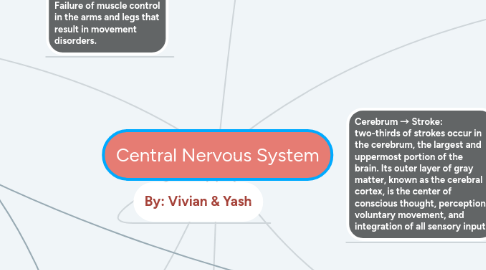
1. The ability to store relate and record information comes from the expanded cerebral cortex.
2. Sciatica → Brain stem: People who suffer from sciatica have problems with motor movements
3. Arachnoid layer → Cerebrospinal fluid: Acts as a cushion to the brain
4. Dura Mater → Blood supply: Dura mater surrounds and supports the large venous channels (dural sinuses) carrying blood from the brain toward the heart
5. The primary function of CSF is to cushion the brain within the skull and serve as a shock absorber for the central nervous system
6. Cerebellum → Ataxias: Failure of muscle control in the arms and legs that result in movement disorders.
7. Meninges
7.1. Dura Mater (tough mother)
7.2. Arachnoid layer
7.3. Pia Mater (delicate mother)
8. Cerebrospinal fluid
9. Brain
9.1. Brain stem
9.1.1. Medulla
9.1.1.1. Located at the base of your brain, where the brain stem connects the brain to your spinal cord. It plays an essential role in passing messages between your spinal cord and brain
9.1.2. Pons varolli
9.1.2.1. Links the medulla oblongata and the thalamus, whose primary function is to regulate breathing, sleeping etc.
9.1.3. Midbrain
9.2. Diencephalon
9.2.1. Thalamus
9.2.2. Hypothalamus
9.2.2.1. Part of the brain that has a vital role in controlling many bodily functions including the release of hormones from the pituitary gland
9.3. Cerebrum
9.3.1. Cerebral cortex
9.3.1.1. The thin layer of the brain that covers the outer portion (1.5mm to 5mm) of the cerebrum, covered by the meninges and often referred to as gray matter
9.3.2. Corpus callosum
9.3.2.1. A large, C-shaped nerve fiber bundle found beneath the cerebral cortex, that stretches across the midline of the brain, connecting the left and right cerebral hemispheres
9.4. Cerebellum
9.5. Blood supply
10. By: Vivian & Yash
11. Brain stem → Reflexes/reflex arc: Serves a critical role in regulating certain involuntary actions of the body, including heartbeat and breathing. The reflexes manage and quickly fast respond to changes in the internal or external environment to maintain homeostasis
12. Sensory → Thalamus: Responsible for interpreting sensory messages, such as touch, received from the body
13. Sensory → Diencephalon: The plethora of communicating pathways between these structures and other parts of the body makes the diencephalon a functionally diverse area
14. Transection → Brain: The degree of neurological compromise corresponds with the degree of cord transection. In partial transection, there may still be some retained sensory-motor function while incomplete transaction there is a complete loss of function
15. Cerebrum → Stroke: two-thirds of strokes occur in the cerebrum, the largest and uppermost portion of the brain. Its outer layer of gray matter, known as the cerebral cortex, is the center of conscious thought, perception, voluntary movement, and integration of all sensory input
16. Functions of the Nervous System
16.1. Sensory input
16.2. Integration
16.3. Motor input
17. Spinal Cord
17.1. Sensory (afferent)
17.2. Motor (efferent)
17.3. Reflexes and reflex arc
17.4. Dermatome
17.5. Ramus
17.5.1. Dermatome has spinal nerves while the ramus and plexus are spinal nerves
17.6. Plexus
17.7. Spinal cord diseases/disorders
17.7.1. Transection
17.7.2. Sciatica
17.7.2.1. Sciatic nerve
17.7.2.1.1. Longest and widest nerve in the human body, running from the lower back, through the buttocks, and down the legs, ending just below the knee
17.7.2.1.2. Controls several muscles in the lower legs and supplies sensation to the skin of the foot and the majority of the lower leg
18. Diseases/disorders
18.1. Ataxias
18.2. Alzheimer's disease
18.2.1. Typically destroys neurons and their connections in parts of the brain involved in memory, including the entorhinal cortex and hippocampus
18.2.2. It later affects areas in the cerebral cortex responsible for language, reasoning, and social behavior
18.3. Dyslexia
18.3.1. A person with a dyslexic brain has a different distribution of metabolic activation than the brain of a person without reading problems when accomplishing the same language task
18.3.2. There is a failure of the left hemisphere rear brain systems to function properly during reading
18.4. Strokes
18.4.1. Blocked or ruptured artery
